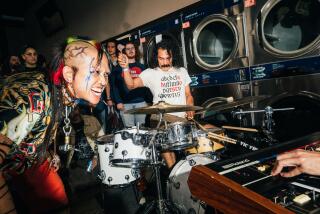Column: Whatever happened to Muzak? It’s now Mood, and it’s not elevator music
- Share via
If you find yourself in a more money-spending mood while shopping at the Target store in West Hills next week, that might be no coincidence. The chain’s San Fernando Valley branch is one of two-dozen Southern California Targets being outfitted with audio systems and specially curated music to shop by.
That’s right: Muzak is back.
Actually, it never left. The big difference nowadays is that the musical manipulation of consumers’ behavior is both more entertaining and presumably more effective.
Oh, and it’s no longer Muzak, which many people might associate with perky renditions of “Girl From Ipanema” while riding an elevator. The firm was acquired in 2011 by Texas’ Mood Media, and the audio service was rechristened with that company’s moniker.
Mood subsequently was purchased by the private equity firms Apollo Global Management and GSO Capital Partners. That deal closed last month.
Danny Turner, Mood’s senior vice president of programming and production, told me that playlists of popular music — as opposed to the generic instrumentals of Muzak past — are now a crucial aspect of differentiating a business in the eyes of consumers.
“Major brands realize that to move forward, these positive, emotional connections have to be made — and there’s no better way to do that than music,” he said.
Muzak, which debuted in 1934, was based on the idea that a catchy soundtrack can put consumers in a shopping state of mind. The company also tinkered with stranger ways that background sounds might influence people’s behavior.
In the 1940s, Muzak introduced what it called “stimulus progression,” which was intended to boost office workers’ productivity by exposing them to instrumental arrangements that gradually increased in tone and tempo over 15-minute cycles. It sold variations of the service to workplaces for decades.
Turner, a former programming exec at XM Satellite Radio (now SiriusXM), called stimulus progression “musical voodoo” and said the service was “really bizarre.”
“It’s almost an intimation that music is being used for nefarious reasons,” he said.
As opposed to unapologetically corporate reasons. Mood says it reaches more than 150 million consumers daily in over 100 countries. U.S. clients include McDonald’s, CVS, Whole Foods and Marriott.
An influential 1982 study on supermarket shoppers published in the Journal of Marketing concluded that “the tempo of instrumental background music can significantly influence both the pace of in-store traffic flow and the daily gross sales volume purchased by customers.”
Interestingly, the study found that “the higher sales volumes were consistently associated with the slower tempo musical selections while in contrast, the lower sales figures were consistently associated with the faster tempo music.”
It attributed the phenomena to the fact that “as customers move more slowly through the store, they tend to buy more.”
A 1990 study in the Journal of Consumer Marketing determined that age is a factor. It found that younger shoppers are cool with music playing loudly in the foreground, whereas older shoppers prefer their tunes playing more softly in the background.
These days, the emphasis seems to be on providing customers with a pleasing, comfortable environment — think iTunes without the earbuds. “What people want are bespoke experiences,” Turner said.
Target began fiddling with the concept in 2011 in a couple of its Minnesota stores. Kristy Welker, a company spokeswoman, told me this represented a complete change for the retail chain.
“For years and years,” she said, “we wanted a distraction-free shopping experience. Then we heard from guests who said they liked the music in our commercials.”
The Minnesota tests inspired Target to introduce music to more of its stores during construction or remodeling. For example, when a new Target opened in downtown Los Angeles in 2012, it came equipped with an audio system. This was also the case with outlets that opened recently in San Diego, Long Beach and near USC.
Along with the West Hills store, music will be arriving any day at Target’s Fullerton and Puente Hills branches.
Welker said the company’s main request to Mood, which is providing the chain’s playlists, is for tunes that are “upbeat,” as befitting the company’s playful branding.
Turner said he and the dozens of DJs who work with him try to do “a deep dive into the DNA of the brand” when compiling an acoustical portrait of a particular business.
It’s apparently harder than it seems. While you don’t have to be a marketing genius to realize that Elton John’s “Funeral for a Friend” might not be a great retail choice, Turner said he and his team go through a variety of permutations before finding that just-right mix for companies.
He declined to discuss specific clients, but he offered the example of a time he and his family stopped by a branch of a major sandwich chain.
The store had a “digital jukebox” that allowed customers to select songs, and someone had picked the hard-rocking “Master of Puppets” from Metallica.
“Don’t get me wrong, I’m a huge fan of Metallica,” Turner said. Still, “hearing ‘Master of Puppets’ while enjoying a tuna salad and some sea-salt chips isn’t necessarily the best experience.”
If he’d been calling the shots, Turner added, the sandwich shop would have been playing a collection of uptempo songs from the ’80s, ’90s and 2000s, including a certain feel-good ditty from Pharrell — musical selections more befitting of the chain’s family-friendly vibe.
Mood says its clients pay anywhere from $25 to $50 monthly per store for personalized playlists. That made me wonder if the Company Formerly Known as Muzak would ever offer a streaming consumer service to compete with the likes of Spotify and Pandora. It seems like a natural extension of the brand.
Turner said I might be on to something. I figure my brainstorm is good for at least a 10% “finder’s fee.”
As the Pet Shop Boys put it: “I’ve got the brains, you’ve got the looks. Let’s make lots of money.”
David Lazarus’ column runs Tuesdays and Fridays. He also can be seen daily on KTLA-TV Channel 5 and followed on Twitter @Davidlaz. Send your tips or feedback to [email protected].
MORE BY LAZARUS
Can customers bring dogs into Starbucks and other coffee shops?
Chiropractic treatment, a $15-billion industry, has its roots in a ghost story
If you’re on a spouse’s health plan, what happens if the worst should happen?
More to Read
The biggest entertainment stories
Get our big stories about Hollywood, film, television, music, arts, culture and more right in your inbox as soon as they publish.
You may occasionally receive promotional content from the Los Angeles Times.











